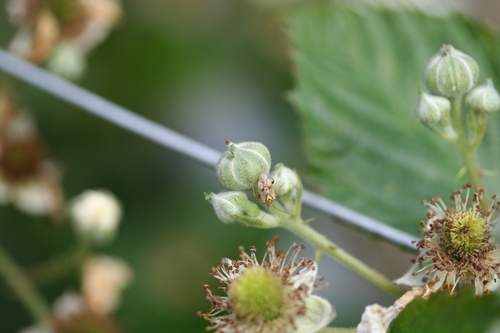As many Central Coast caneberry growers know, this summer season has seen an astonishing number of lygus bugs in blackberries. Counts of 10 to 20 lygus bugs per shake easily rival the heaviest infestations in strawberry.
However, contrary to the “catfacing” or misshapen fruit left by lygus activity in strawberry, there does not seem to be a documented type of damage from lygus in blackberry. All the same, customers have been getting tetchy about having bugs in their baskets of fruit, so it is indeed important for us as an industry to take this on.
Unfortunately, management of lygus in blackberry has proven to be just as difficult in blackberry as strawberry, perhaps even more so since there are fewer insecticides registered for use in blackberries.
Thrips incidentally occur in blackberry flowers as well and did in great numbers in this trial. Again it is not certain whether or not they cause a lot of damage. Nevertheless, thrips were also evaluated in this trial since they are a known pest in other crops and situations.
The organically registered insecticides MPede and Aza-Direct have shown promise in controlling stink bugs (same insect order as lygus bugs), so the study described below is a screen these two materials compared against a grower applied standard of Diazinon along with an untreated control.
Trial was composed of 4 24 ft x 26 ft replicated treatments in a blackberry field with significant lygus and thrips activity. MPede and Aza-Direct were applied with a motorized backpack sprayer by Brian Deeter from Gowan Company. Diazinon was applied at the label rate by the grower in an adjacent block, so while not part of the experimental design, it did provide reasonably strong information in comparison to the three other treatments.
My research assistant and I did the evaluations which consisted of shaking 3 feet of flowering blackberry hedgerow into a five gallon bucket for the lygus and agitating three mature flowers individually onto a white sheet of paper and counting the expulsed thrips there. Dates of evaluation were August 11 (pre-application), August 15 and August 19 (one week post application).
As the reader can see from the chart below, beyond Diazinon there is little effect on field populations of lygus or thrips from either MPede or Aza-Direct. Furthermore, the lack of thorough control of lygus and thrips by Diazinon, long regarded as one of the most powerful pesticides available to blackberry growers, is unsettling.
|
Character Rated |
lygus |
thrips |
lygus |
thrips |
lygus |
thrips |
|||||||
|
Rating Date |
Pre-app |
Pre-app |
8/15/2011 |
8/15/2011 |
8/19/2011 |
8/19/2011 |
|||||||
|
1 |
MPede + Aza-Direct |
35.75 |
a |
84.50 |
a |
31.50 |
a |
72.00 |
ab |
16.50 |
a |
54.75 |
ab |
|
2 |
MPede |
28.75 |
a |
56.50 |
a |
37.25 |
a |
120.25 |
a |
19.50 |
a |
67.75 |
a |
|
3 |
UTC |
36.00 |
a |
73.50 |
a |
34.75 |
a |
104.75 |
a |
15.50 |
a |
52.00 |
ab |
|
4 |
Diazinon |
22.50 |
a |
38.25 |
a |
11.25 |
b |
34.50 |
b |
11.50 |
a |
24.25 |
b |
Means followed by same letter do not significantly differ (P=.05, Student-Newman-Keuls)
Mean comparisons performed only when AOV Treatment P(F) is significant at mean comparison OSL.
Finally, it will be worth my while to return to this field to evaluate the effect, if any, this pest load is having on fruit development. As already mentioned above, beyond the contamination of harvested fruit, thrips and lygus damage to blackberry has not yet been well defined.
There are a number of pesticides mentioned for management of lygus and thrips in this article. Before using any of these products, check with your local Agricultural Commissioner's Office and consult product labels for current status of product registration, restrictions, and use information.
Attached Images:

Lygus bug adult on unopened blackberry flower